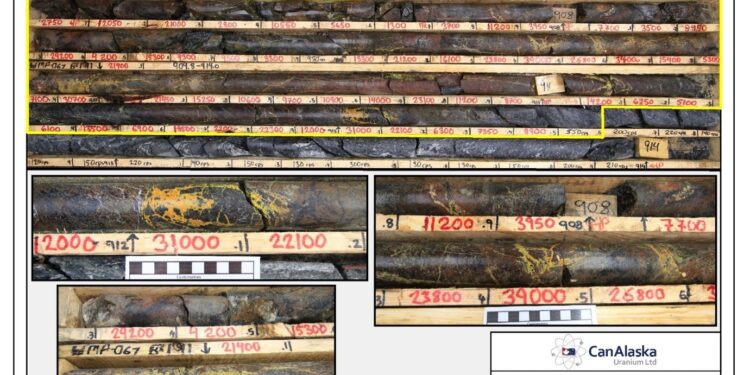CanAlaska Uranium Ltd (TSXV: CVV) has intersected a wide interval of basement-hosted uranium mineralisation along a newly defined exploration trend on the West McArthur project in Canada’s Athabasca Basin.
Drill hole WMA067 was the second regional test of the current summer drilling programme. The drill hole intersected a broad, 6.3 metre-long interval of elevated radioactivity (> 300 counts per second (cps) on a handheld CT007-M scintillometer).
The broad interval includes several metre- to sub-metre-long intervals of moderate to strong radioactivity, one of which is 3.5 metres long (> 5,000 cps on the CT007-M). WMA067 is located six kilometres along strike to the southwest of the company’s 42 Zone mineralisation
The uranium mineralisation is characterised by pitchblende and yellow uranium secondaries with associated clay and hematite alteration in faulted basement rocks approximately 100 metres below the unconformity.
“The CanAlaska team has delivered a new uranium intersection in a new area of the West McArthur project with its second drill hole of the summer programme,” CEO, Cory Belyk, said.
“With multiple recently announced build-outs of small modular reactors (“SMRs”) in the Canadian market alone, the need for more uranium discoveries that can lead to increased production has never been more apparent.
“The West McArthur project, strategically located next to critical mine and mill infrastructure in the eastern Athabasca Basin, continues to respond positively to targets generated by the geological team providing additional opportunities for discovery for our shareholders. This is an important and exciting result early in the 2022 drilling programme.”
Drill hole WMA067 was designed to test a strong conductor anomaly identified during the 2022 winter geophysical programme. The drillhole penetrated 52.8 metres of overburden followed by Athabasca sandstone to 803.8 metres.
The lower 80 metres of the sandstone column is strongly bleached with several fault zones containing limonite alteration and de-silicification. Two major metre-scale fault zones in the basal sandstone, the lowermost of which straddles the unconformity, are associated with strong clay, limonite, and strongly de-silicified core resulting in approximately 30% core recovery.
The basement of WMA067 consists of a wide package of graphitic and non-graphitic pelitic metasediments, explaining the conductive response. In the immediate 30 m below the unconformity, the metasedimentary package is overprinted by strong clay, chlorite, and hematite alteration associated with multiple fault zones that contain clay gouge, broken core, and cataclastic breccias.
The remainder of the basement intersection is variably clay and chlorite-altered, increasing in intensity around intervals of increased fracturing as damage zones to graphitic fault zones. The intensity of the basement alteration increases with depth, leading up to the basement-hosted uranium mineralization. The mineralisation is structurally-controlled within a broad graphitic shear zone that hosts several re-activated faults. The mineralisation, starting at 906.3 m, is characterised by massive to semi-massive, vein-controlled, and disseminated pitchblende and yellow uranium secondaries that are associated with bleaching, clay, and hematite alteration. Core recovery throughout the basement intersection is 100%.
For further information please visit: https://canalaska.com/












